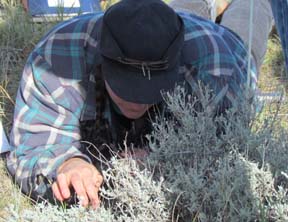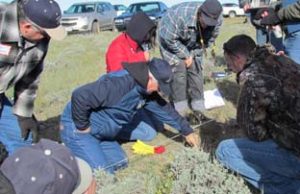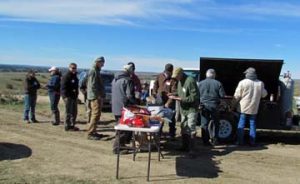Stakeholders learn about a variety of different ways to assess wildlife habitat and rangeland health on the CMR NWR
 The brisk fall weather of early October did not hamper more than 50 people from gathering on the Charles M. Russell National Wildlife Refuge north of the Fort Kipp Recreation Area to learn about rangeland monitoring. The Monitoring Roundup was organized and sponsored by members of the Charles M. Russell National Wildlife Refuge Community Working Group (CMR CWG). The purpose of the event was to help diverse stakeholders come to a common understanding of how land is evaluated and how that information may be used in management decisions.
The brisk fall weather of early October did not hamper more than 50 people from gathering on the Charles M. Russell National Wildlife Refuge north of the Fort Kipp Recreation Area to learn about rangeland monitoring. The Monitoring Roundup was organized and sponsored by members of the Charles M. Russell National Wildlife Refuge Community Working Group (CMR CWG). The purpose of the event was to help diverse stakeholders come to a common understanding of how land is evaluated and how that information may be used in management decisions.
A total of 5 hands-on learning stations were provided by the Bureau of Land Management (BLM), the Natural

Resource Conservation Service (NRCS), the US Fish and Wildlife Service (CMR NWR Employees), Jason and Sierra Holt (local residents), and Roland Kroos, a private consultant who specializes in holistic management (Holistic Management in Motion). Each of the presenters provided an overview of the main points of the monitoring methods employed by their agency/operation and the reasons behind them establishing a monitoring protocol. While the methodology varied greatly among the presenters in both the types and the complexity of the information gathered, no single method was identified as the “right” or “wrong” way to monitor.
Rather, all the presenters emphasized that monitoring should be tailored to your individual needs, skills, and land management goals. For example, the CMR NWR was established for the protection of habitat for sharp-tail grouse and pronghorn antelope. Rightly so, their monitoring protocol is geared toward assessing habitat for these specific animals. On the other hand, the Holts’ monitoring protocol is quite detailed, requires honed plant identification skills and a significant time commitment, but matches their skills and the management objectives of their family’s livestock operation.

“A big part of monitoring is just teaching yourself to pay attention to the land. Look down at the ground, not just across the landscape, and you will get a different picture of what is happening on the land.” That was advice from Roland Kroos who also encouraged landowners to build a relationship with agency personnel and be aware of what documentation is going into their agency file. Rick Caquelin and Jon Siddoway of the NRCS urged landowners to make monitoring a priority in their operation and commit to getting it done every year. The variation in forage production between years can be very dramatic on rangeland and wrong assumptions can be arrived at if one does not have a way to differentiate between yearly climate variation and management induced changes.

Attendees enjoyed an excellent meal provided by members of the Missouri River Conservation District Council, Garfield County Conservation District (CD), Petroleum County CD, Phillips County CD, and McCone County CD, Dyrck Van Hynning, and the American Prairie Reserve; with Phillips County residents Marko Manoukian and Mike Lang mastering the burgers on the grill. Those who persevered to the end were rewarded with an amazing display of elk at the Slippery Ann Elk Viewing Area.
The C. M. Russell National Wildlife Refuge (CMR) Community Working Group was established in July 2010 to discuss management of the C. M. Russell National Wildlife Refuge (CMR); recognize conflicts and commonalities among users, groups and agencies; identify and work collaboratively toward solutions; and provide a discussion forum for increased understanding, cooperation, and partnership among stakeholders.

Participants include CMR management, landowners, grazing permittees, agency representatives, county commissioners, conservation districts, business owners, outfitters, wildlife organizations, environmental groups, recreationists, and others. Meetings are held bi-monthly around the region and are open for public attendance. For more information on the CMR CWG or their meeting schedule, contact Rachel Frost, mrcdc@macdnet.org, 406-454-0056.
